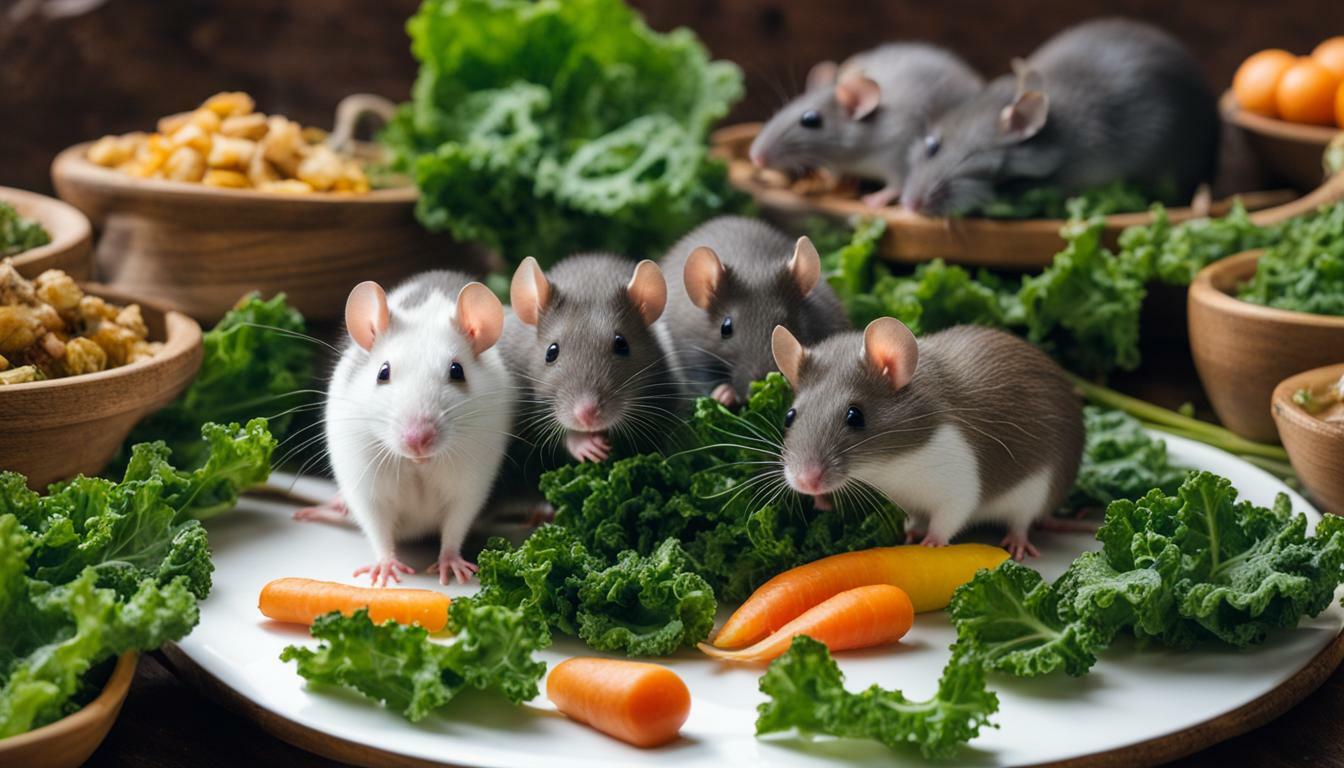If you’re wondering whether it’s safe to give kale to your pet rats, you’ve come to the right place. Rats can indeed enjoy the nutritional benefits of kale without any problems. This leafy green vegetable is packed with essential vitamins and minerals that contribute to their overall well-being. Keep reading to discover more about kale and how to incorporate it into your rat’s diet.
Key Takeaways:
- Kale is safe for rats to eat and provides them with important vitamins and minerals.
- Rats can consume both raw and cooked kale, but be sure to wash it thoroughly to remove any pesticides.
- Steaming kale is a recommended method of preparation to preserve its nutrients.
- If your rat doesn’t enjoy kale, there are other vegetables such as broccoli, cauliflower, mushrooms, and zucchini that you can offer instead.
- Remember to provide a variety of fruits and vegetables to ensure a balanced diet for your furry friend.
The Nutritional Value of Kale for Rats
Kale is a nutrient-dense vegetable that offers several health benefits for rats. It is rich in vitamins A, K, and C, which contribute to their overall well-being. Vitamin A is essential for maintaining good vision and a healthy coat, while vitamin K plays a crucial role in blood clotting and bone health. Additionally, vitamin C is an important antioxidant that helps support the immune system and protects against cellular damage.
Aside from vitamins, kale is also a great source of minerals like manganese, copper, calcium, and potassium. These minerals contribute to various bodily functions, including bone development, nerve function, and muscle contraction. Manganese, for example, is essential for the production of connective tissues and plays a role in maintaining proper brain function. Meanwhile, copper aids in the production of red blood cells and helps with iron absorption.
If you’re wondering how to prepare kale for your rat, both raw and cooked forms are safe for them to consume. However, it is crucial to wash the vegetable thoroughly to remove any pesticides. When cooking kale, steaming is recommended over boiling to retain its nutritional value. Rats can even eat the stems of kale, so no part of this vegetable needs to go to waste.
| Vitamins | Minerals |
|---|---|
|
|
If your rat isn’t a fan of kale, there are other leafy greens that you can offer as alternatives. Broccoli and cauliflower are great options rich in vitamins and minerals. Mushrooms offer unique health benefits, such as boosting the immune system and supporting liver function. Additionally, zucchini is a low-calorie vegetable that provides hydration and dietary fiber for your rat.
Remember, variety is key when it comes to feeding your rat a balanced diet. By offering a mix of different fruits and vegetables, you can ensure they receive a wide range of nutrients and enjoy their meals. As always, consult with a veterinarian for personalized advice on your rat’s dietary needs and any potential concerns or allergies.
Feeding Kale to Rats
When introducing kale to your rat’s diet, there are a few things to keep in mind to ensure their safety and enjoyment. Rats can safely eat both raw and cooked kale, so you can choose the preparation method that works best for you and your furry friend. However, it is important to wash the vegetable thoroughly before serving it to remove any pesticides that may be present. This can be done by rinsing the kale under running water and gently scrubbing it with your hands.
If you prefer to cook the kale, it is recommended to steam it rather than boiling it. Steaming helps preserve the nutrients in the vegetable and can be done by placing the kale in a steamer basket over boiling water for a few minutes until it becomes tender. Remember to allow the kale to cool down before offering it to your rat.
In addition to the leaves, rats can also enjoy the stems of kale. These can provide an extra crunch and variety in texture for your pet. However, make sure to chop the stems into appropriate bite-sized pieces to prevent any choking hazards.
If your rat doesn’t seem to enjoy kale or you want to offer some variety in their diet, there are other safe vegetables you can feed them. Broccoli, cauliflower, mushrooms, and zucchini are all good alternatives. These vegetables also provide essential nutrients like vitamins and minerals that contribute to your rat’s overall health and well-being. Remember to introduce new foods gradually and monitor your rat’s response to ensure they tolerate and digest them well.
| Vegetable | Nutritional Benefits |
|---|---|
| Kale | Rich in vitamins A, K, and C; minerals like manganese, copper, calcium, and potassium |
| Broccoli | High in fiber, vitamins C and K, and minerals such as potassium and folate |
| Cauliflower | Contains vitamins C and K, as well as minerals like potassium and magnesium |
| Mushrooms | Good source of vitamins B and D, as well as minerals such as selenium and copper |
| Zucchini | Low in calories, high in water content, and a good source of vitamins A and C |
Remember to offer a variety of fruits and vegetables to ensure a balanced diet for your rat. By providing them with different options, you can ensure they receive all the necessary nutrients they need to thrive. If you have any concerns about your rat’s diet or notice any signs of allergies or digestive issues, it is always best to consult a veterinarian for personalized advice.
If your rat isn’t a fan of kale or you’re looking to provide some variety in their diet, there are other leafy greens that can be equally beneficial for them. Broccoli, cauliflower, mushrooms, and zucchini are all nutritious options that rats can safely consume. These vegetables offer a variety of vitamins, minerals, and antioxidants that contribute to your rat’s overall health.
When feeding your rat leafy greens, it’s important to remember to wash them thoroughly to remove any potential pesticides. This can be done by rinsing the vegetables under running water or soaking them in a vinegar and water solution. You can offer these greens raw or cooked, depending on your rat’s preference. Some rats may prefer the taste of cooked vegetables, while others may enjoy them raw.
To create a balanced diet for your rat, it’s essential to offer them a variety of fruits and vegetables. This ensures that they receive a wide range of nutrients. You can rotate different types of leafy greens, along with other fruits and vegetables, to provide your rat with a diverse and nutritious diet.
In addition to leafy greens, it’s important to offer your rat a complete and balanced rat food, which is specially formulated to meet their nutritional needs. This provides a solid foundation for their diet and should be the main component of their meals. Leafy greens, along with other fruits and vegetables, can be offered as a supplement to enhance their diet and provide additional nutrients.
By incorporating a variety of leafy greens and other fruits and vegetables into your rat’s diet, you can ensure that they receive a well-rounded and nutritious meal. Remember to consult with a veterinarian for personalized advice and to monitor your rat’s health and well-being. Providing a diverse range of foods will not only keep your rat healthy but also add enjoyment to their mealtime.
| Leafy Greens for Rats | Nutritional Benefits |
|---|---|
| Broccoli | High in vitamins C and K, as well as fiber and antioxidants |
| Cauliflower | Rich in vitamins C and K, as well as minerals like potassium and manganese |
| Mushrooms | Good source of B vitamins, as well as minerals like selenium and copper |
| Zucchini | Contains vitamins A and C, as well as potassium and manganese |
Including a Variety of Fruits and Vegetables
Alongside kale and leafy greens, it’s crucial to incorporate a variety of fruits and vegetables into your rat’s diet for optimal health. Rats have complex nutritional needs, and a diverse range of produce can help provide the necessary vitamins, minerals, and fiber they require.
When selecting fruits and vegetables for your rat, consider offering both raw and cooked options. Raw fruits and veggies can be given as crunchy treats while cooked ones can provide a softer, easily digestible option. Be sure to wash all produce thoroughly to remove any dirt or pesticides.
Some fruits and vegetables that rats can enjoy include:
- Berries: Rats love strawberries, blueberries, and raspberries as a sweet treat.
- Apples and pears: These fruits should be seeded and sliced into small, bite-sized pieces.
- Carrots: A crunchy, low-calorie snack that is rich in vitamin A.
- Bell peppers: Red, green, and yellow bell peppers are a great source of vitamin C.
Remember to introduce new foods gradually to your rat’s diet and monitor their response. If you notice any signs of allergies or digestive issues, consult with a veterinarian for guidance.
| Fruits | Vegetables |
|---|---|
| Berries | Carrots |
| Apples | Bell peppers |
| Pears |
Preparing Kale for Rats
Before serving kale to your rat, it’s essential to prepare it in a way that is safe and easy for them to consume. Start by removing any tough stems from the kale leaves, as these can be difficult for rats to chew and digest. Once the stems are removed, chop the kale into bite-sized pieces that are appropriate for your rat’s size.
Pro Tip: If your rat is a picky eater, try finely chopping the kale and mixing it with their regular food to make it more enticing.
When it comes to cooking kale for your rat, both raw and cooked kale are safe options. However, it’s important to wash the vegetable thoroughly before serving it to remove any pesticides that may be present. Steaming kale is recommended over boiling it, as this cooking method helps to preserve the vegetable’s nutrients.
Did You Know? Rats can also eat the stems of kale, so there’s no need to discard them. However, some rats may find the stems too tough to chew, so it’s best to observe your rat’s preference and adjust accordingly.
| Kale Preparation Tips | |
|---|---|
| Remove tough stems | Chop into bite-sized pieces |
| Wash thoroughly to remove pesticides | Steam instead of boiling to preserve nutrients |
| If desired, mix with regular food to entice picky eaters | |
If your rat doesn’t take to kale or you’re looking to provide more variety, there are other vegetables that can be offered as safe alternatives. Broccoli, cauliflower, mushrooms, and zucchini are all suitable options that rats can enjoy as part of a healthy diet. Remember, it’s important to offer a variety of fruits and vegetables to ensure your rat receives a balanced nutritional intake.
By taking these precautions and preparing kale in a way that is safe and palatable for your rat, you can confidently include this nutrient-packed vegetable as part of their diet. As always, keep a close eye on your rat’s health and consult a veterinarian if you have any concerns or notice any adverse reactions to the introduction of new foods.
Common Concerns About Feeding Kale to Rats
While kale is generally safe for rats, it’s important to address some common concerns you may have about including it in their diet. One concern is whether rats can eat the stems of kale. The good news is that rats can indeed enjoy the stems along with the leaves. The stems provide additional fiber and nutrients, making them a healthy part of a rat’s diet. So, don’t hesitate to include the whole kale plant when feeding your furry friends.
Another concern revolves around the potential digestive issues that kale may cause for rats. It’s true that some rats may experience gas or loose stools when first introduced to kale. However, these symptoms usually subside as the rat’s digestive system adjusts to the new food. To minimize any digestive discomfort, start by offering small amounts of kale and gradually increase the portion size over time.
One more concern is whether rats may develop allergies to kale. While rare, it is possible for rats to have an allergic reaction to kale, just like humans can have allergies to certain foods. If you notice any signs of an allergic reaction, such as itching, hives, or difficulty breathing, it’s important to discontinue feeding kale to your rat and consult with a veterinarian for further guidance.
In summary, kale is generally safe to include in a rat’s diet. It offers numerous health benefits and can be served both raw and cooked. Remember to wash the kale thoroughly to remove any pesticides, and consider steaming it to preserve its nutrients. If your rat doesn’t enjoy kale, you can offer alternative leafy greens like broccoli, cauliflower, mushrooms, and zucchini. And, as always, it’s important to provide a variety of fruits and vegetables to ensure a balanced diet for your furry friend.
| Common Concerns About Feeding Kale to Rats |
|---|
| Can rats eat the stems of kale? |
| Yes, rats can eat both the stems and leaves of kale. |
| Are there any potential digestive issues? |
| Some rats may experience gas or loose stools when first introduced to kale, but these symptoms typically subside over time. |
| Can rats develop allergies to kale? |
| While rare, rats can have allergic reactions to kale. If any signs of an allergic reaction are observed, discontinue feeding kale and consult a veterinarian. |
Monitoring Your Rat’s Health
As a responsible rat owner, it’s crucial to keep a close eye on your rat’s health and behavior when introducing new foods like kale. While kale is generally safe for rats to consume, it’s important to monitor their response to ensure they tolerate it well. Here are some key points to consider as you introduce kale into your rat’s diet:
- Observe your rat’s eating habits: Pay attention to how your rat reacts to kale. Do they eagerly eat it or show disinterest? It’s important to make sure they consume an adequate amount of kale to benefit from its nutrients.
- Monitor stool consistency: Keep an eye on your rat’s droppings after introducing kale. If their stool becomes loose or watery, it could be a sign of digestive upset. In such cases, it’s advisable to reduce the amount of kale given or discontinue it altogether.
- Watch for signs of allergies: While rare, some rats may be allergic to kale or other leafy greens. Look out for symptoms such as skin rashes, itchiness, or respiratory distress. If you notice any adverse reactions, consult a veterinarian for further guidance.
By closely observing your rat’s health and behavior, you can ensure that their diet supports their overall well-being. Remember, offering a variety of fruits and vegetables alongside kale will provide a balanced nutritional profile for your furry friend.
| Key Considerations for Monitoring Your Rat’s Health |
|---|
| Observe eating habits |
| Monitor stool consistency |
| Watch for signs of allergies |
Conclusion
In conclusion, rats can enjoy the health benefits of kale as part of their diet, but it’s essential to provide them with a diverse array of fruits and vegetables for a complete and nutritious meal.
Kale is a nutrient-dense vegetable that contains vitamins A, K, and C, as well as minerals like manganese, copper, calcium, and potassium. Rats can safely consume both raw and cooked kale, but it’s important to wash the vegetable thoroughly to remove any pesticides. Steaming kale is recommended over boiling it to preserve its nutrients. Additionally, rats can also eat the stems of kale, so no part of the vegetable goes to waste.
If your rat doesn’t particularly enjoy or tolerate kale, there are alternative leafy greens you can offer them, such as broccoli, cauliflower, mushrooms, and zucchini. These vegetables also provide nutritional value and can be incorporated into your rat’s diet.
To ensure a balanced diet, it’s crucial to offer a variety of fruits and vegetables to your rat. This will ensure they receive a wide range of nutrients and contribute to their overall well-being. Remember to introduce new foods gradually and monitor your rat’s response, as some rats may have specific dietary requirements or sensitivities.
For personalized advice and guidance on your rat’s diet, it’s always a good idea to consult with a veterinarian. They can provide tailored recommendations and address any specific concerns you may have regarding feeding kale or any other food to your furry friend.
FAQ
Can rats have kale?
Yes, rats can safely consume kale without any problems.
What is the nutritional value of kale for rats?
Kale is a nutrient-dense vegetable that contains vitamins A, K, and C, as well as minerals like manganese, copper, calcium, and potassium, which are beneficial for rats.
How should I feed kale to rats?
Rats can eat both raw and cooked kale, but be sure to wash the vegetable thoroughly to remove any pesticides. It is recommended to steam kale instead of boiling it to preserve its nutrients. Rats can also eat the stems of kale.
What are some other leafy greens that rats can eat?
If your rat doesn’t like kale, you can try feeding them other vegetables like broccoli, cauliflower, mushrooms, and zucchini, which are safe and nutritious for rats.
Should I offer a variety of fruits and vegetables to rats?
Yes, it is important to offer a diverse range of fruits and vegetables to ensure a balanced diet for rats. This helps meet their nutritional needs.
How should I prepare kale for rats?
When preparing kale for rats, remove any tough stems and chop it into appropriate bite-sized pieces. Introduce new foods gradually and monitor your rat’s response.
Are there any common concerns about feeding kale to rats?
While rats can safely eat kale, some concerns may include potential digestive issues or allergies. It is important to serve kale in moderation and monitor your rat’s health.
How should I monitor my rat’s health when introducing kale?
When introducing kale or any new food, monitor your rat for signs of potential allergies or digestive issues. If any problems arise, consult a veterinarian for personalized advice.
Can rats have kale as part of a balanced diet?
Yes, rats can have kale as part of a balanced diet, along with a variety of other fruits and vegetables. Consult a veterinarian for personalized guidance.




